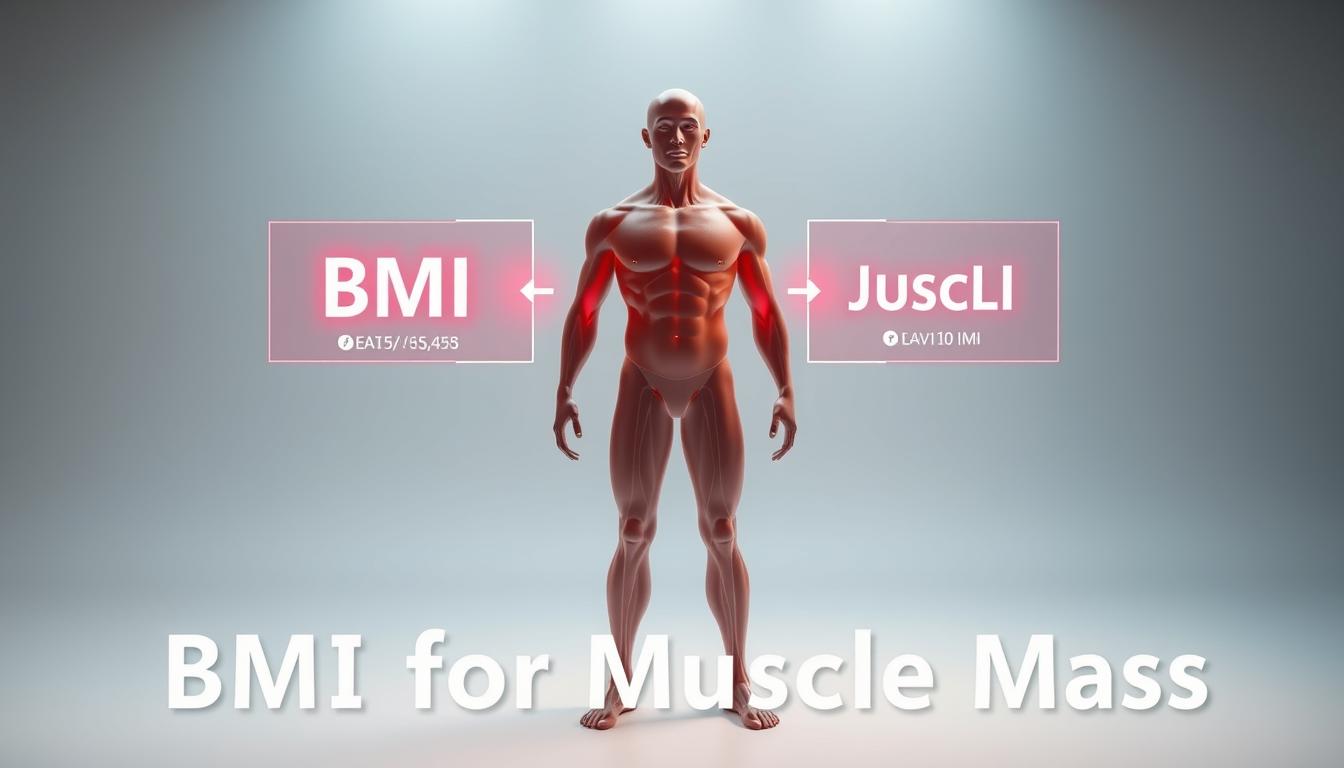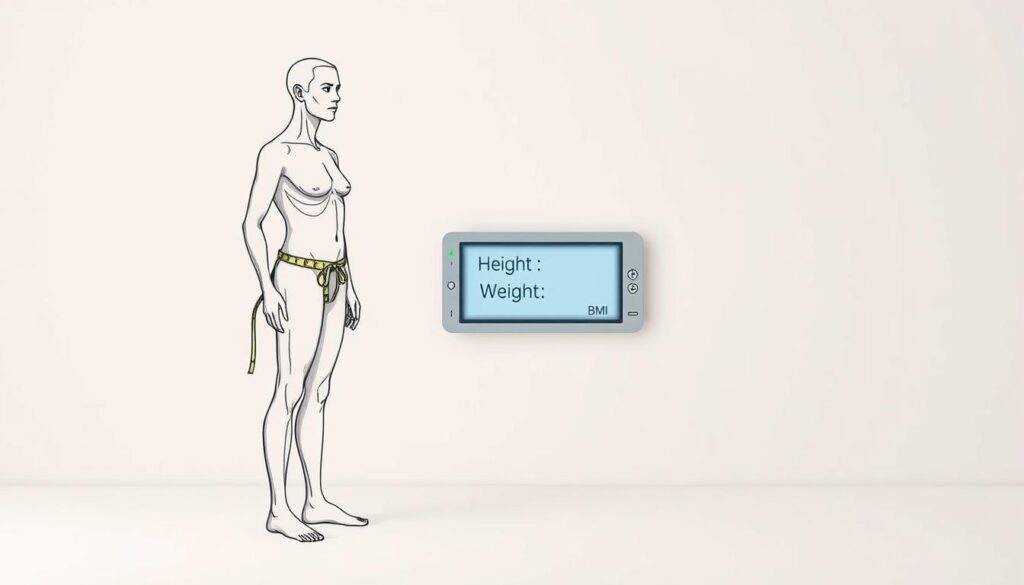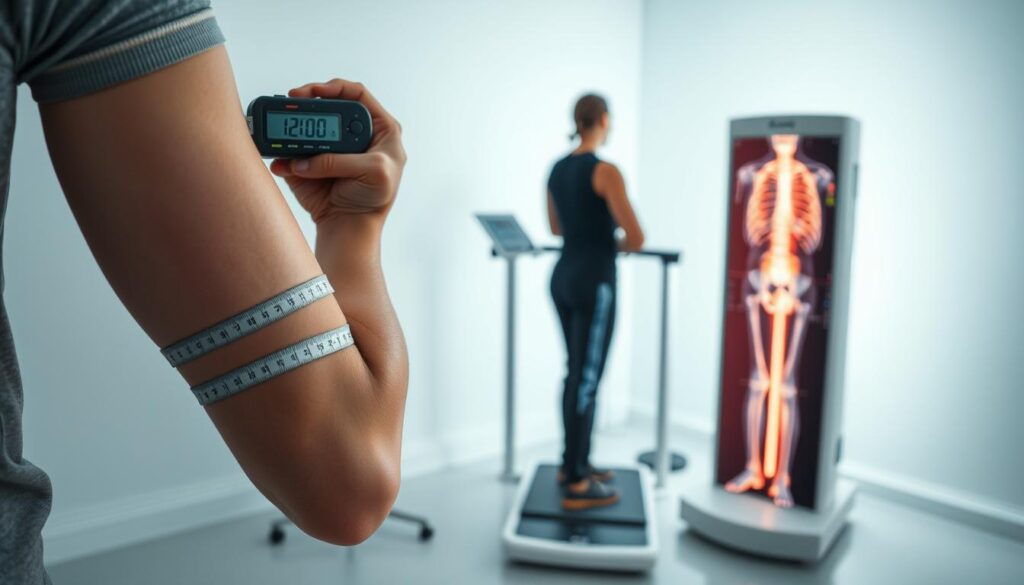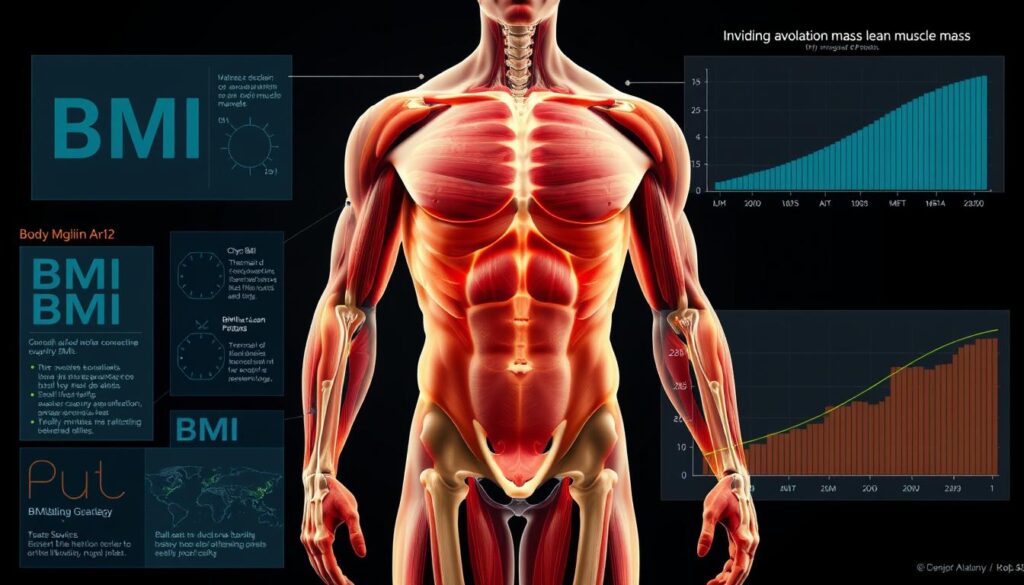Are we misjudging our health and fitness levels by relying solely on BMI?
Body Mass Index (BMI) is often used to check weight status. But, it has its limits when it comes to muscle mass. Recent studies suggest BMI might not show the real picture of body composition or muscle mass index.
Looking into the connection between BMI and muscle mass is key. BMI doesn’t directly measure health or fitness. We’ll see how BMI is used and its shortcomings. Then, we’ll dive deeper into muscle mass and why it matters.
Key Takeaways
- BMI has limitations in assessing health and fitness.
- Muscle mass index is a more accurate measure of body composition.
- Relying solely on BMI can be misleading.
- A more comprehensive approach is needed to assess overall health.
- Understanding muscle mass is crucial for fitness and health.
Understanding BMI and Its Limitations
The concept of BMI has been around for decades. But, its relevance and accuracy are being questioned, mainly for those with high muscle mass. BMI, or Body Mass Index, is a widely used metric to assess weight status. Yet, it has its drawbacks.
What is BMI?
BMI is a simple calculation using a person’s height and weight. It categorizes them into various weight status categories. It is widely used due to its simplicity and ease of calculation. But, it doesn’t differentiate between lean body mass (muscle) and body fat.
How is BMI Calculated?
BMI is calculated by dividing a person’s weight in kilograms by their height in meters squared (kg/m^2). The formula is straightforward: BMI = weight (kg) / height (m)^2. For example, if a person weighs 70 kg and is 1.75 m tall, their BMI would be 22.86.
- Measure your weight in kilograms.
- Measure your height in meters.
- Square your height.
- Divide your weight by your squared height.
Why BMI Can Be Misleading for Athletes
Athletes or individuals with a high muscle mass may have a high BMI without being overfat. This is because muscle is denser than fat. So, when calculating BMI, it can categorize muscular individuals as overweight or obese, even if they have a low body fat percentage. For instance, a bodybuilder with low body fat might have a BMI that categorizes them as obese due to their high muscle mass.
Some key points to consider:
- BMI does not account for body composition.
- It may misclassify athletes or muscular individuals as overweight.
- It is not a direct measure of health or fitness.
While BMI can provide a general indication of weight status, it’s essential to consider other factors. Such as body fat percentage and waist circumference. This is to get a more accurate picture of health, for athletes or those with high muscle mass.
The Importance of Muscle Mass Measurement
Measuring muscle mass is key to good health and wellness. It affects not just how we look but also our metabolic health, strength, and how well we function.
Why Muscle Mass Matters
Muscle mass is essential for staying strong, keeping bones healthy, and maintaining metabolic health. As we get older, we naturally lose muscle, a condition called sarcopenia. This can make us frail and increase the risk of falls and fractures. So, it’s important to keep or grow muscle through exercise and good nutrition as we age.
Muscle mass also plays a significant role in glucose metabolism. Muscles help take up glucose in the body. Having more muscle can make insulin work better, lowering the risk of type 2 diabetes.
Different Methods to Measure Muscle Mass
There are several ways to measure muscle mass, each with its own benefits and drawbacks. Some common methods include:
- Dual-Energy X-ray Absorptiometry (DEXA): This method is very accurate. It measures bone density and can tell the difference between fat and lean mass.
- Hydrostatic Weighing: This method calculates body fat percentage by weighing a person underwater.
- Bioelectrical Impedance Analysis (BIA): This method sends an electrical current through the body to estimate body composition.
How Muscle Mass Impacts Health
Muscle mass greatly affects our overall health. For example, having enough muscle can improve physical performance and lower the risk of diseases like diabetes and heart disease. It also helps our mental health by reducing anxiety and depression symptoms.
Experts are now focusing more on muscle mass and body composition than just BMI. This is highlighted in an article on Abbott’s Nutrition News. They see muscle mass and body composition as key to defining what’s healthy.
The Relationship Between BMI and Muscle Mass
BMI and muscle mass are closely linked and affect our health and body shape. Knowing how they relate is key for athletes, fitness fans, and anyone wanting to stay healthy.
How Muscle Mass Influences BMI Results
Muscle mass greatly affects BMI results. BMI uses weight and height to calculate a number. People with lots of muscle might have a high BMI but not be overweight or obese.
Key factors to consider:
- Muscle density: Muscle is denser than fat, which can affect BMI readings.
- Body composition: The muscle to fat ratio impacts health and BMI.
- Athletic performance: More muscle mass often means better sports performance and health.
Why Athletes May Have High BMIs
Athletes often have more muscle mass due to their training. This can make their BMI seem higher. But it doesn’t mean they’re unhealthy. For example, a pro football player might have a high BMI from muscle, but they’re likely healthier than someone with a similar BMI but more body fat.
The distinction is crucial because BMI alone isn’t enough to judge health. Athletes and those with lots of muscle might need other metrics to truly understand their health.
The Impact of Body Composition on Health
Body composition, like muscle to fat ratio, greatly affects health. More muscle is linked to better health, like lower risks of diseases like diabetes and heart disease.
- Keeping a healthy body composition is vital.
- Exercise and a balanced diet help maintain a healthy body composition.
- Tracking body composition gives a clearer health picture than BMI alone.
Understanding BMI, muscle mass, and body composition helps us better judge health and fitness. It’s important to look at many factors, not just BMI, when assessing health.
Alternative Metrics to Assess Muscle Mass
Beyond BMI, there are other ways to measure muscle mass and its health impact. BMI gives a basic idea, but these other metrics offer a deeper look at body composition.
Waist-to-Hip Ratio
The waist-to-hip ratio is a key metric for body fat distribution. It shows health risks linked to belly fat. You get it by dividing your waist by your hip. A higher ratio means more health risks, like heart disease and diabetes.
Benefits of Waist-to-Hip Ratio:
- Shows fat distribution and health risks
- Simple to measure and calculate
- Gives a detailed health view beyond BMI
Body Fat Percentage
Body fat percentage measures body fat against lean body mass. It’s different from BMI, which mixes fat and muscle. Athletes or those with lots of muscle might have a high BMI but not be overfat.
For instance, a bodybuilder might be seen as overweight by BMI due to muscle. But their body fat percentage shows their true health.
Lean Body Mass Index
Lean Body Mass (LBM) Index focuses on body mass minus fat. It’s great for athletes or those with lots of muscle. It helps see how muscle mass relates to health.
Advantages of LBM Index:
- Shows muscle mass clearly
- Good for athletes and those with lots of muscle
- Helps in making fitness and nutrition plans
Looking at waist-to-hip ratio, body fat percentage, and lean body mass index gives a full view of muscle mass and health. These, along with BMI, help us understand health and fitness better. They give a more optimal muscle mass BMI assessment.
Adjusting Our Perception of BMI
Understanding BMI is key to better health checks. It helps us tell the difference between being fit and being fat. We need a deeper look at BMI to really know someone’s health.
Recognizing Fitness vs. Fatness
BMI has a big flaw: it can’t tell lean body mass from body fat. This mistake can say someone with lots of muscle is overweight, even if they’re not. For example, athletes with lots of muscle might have a high BMI but not be overfat.
To truly check health, we should look at body fat and waist-to-hip ratio, not just BMI. This gives us a clearer picture of someone’s health.
Strategies to Interpret BMI Data
Getting the most from BMI data takes a few steps. Here are some ways to do it:
- Look at body composition along with BMI.
- Check health markers like blood pressure and cholesterol levels.
- Think about lifestyle, like diet and exercise.
The infographic above shows how to better understand BMI. It shows the need for a complete health check.
| Metric | Description | Health Implication |
|---|---|---|
| BMI | Body Mass Index | General indicator of health status |
| Body Fat Percentage | Percentage of body weight that is fat | Shows health risks from too much fat |
| Waist-to-Hip Ratio | Ratio of waist to hip size | Tells about fat distribution and health risks |
The Role of Nutrition and Exercise
Nutrition and exercise are crucial for body shape and health. Eating right and staying active can change BMI and health.
By focusing on diet and exercise, people can get healthier, even if their BMI is not perfect. This not only improves physical health but also boosts mental well-being.
The Role of Technology in Measuring Body Composition
Technology is key in today’s body composition analysis. It gives us insights that go beyond just BMI. Advanced tech helps us understand muscle mass and body fat more accurately.
Smart Scales and Body Fat Monitors
Smart scales and body fat monitors are popular for tracking body composition at home. They use bioelectrical impedance analysis (BIA) to measure body fat, muscle, and health metrics. They’re not as precise as some methods but are easy to use and track changes over time.
Key Features of Smart Scales and Body Fat Monitors:
- Bioelectrical impedance analysis (BIA) technology
- Estimates body fat percentage and muscle mass
- Tracks changes in body composition over time
- User-friendly interface and mobile app connectivity
DEXA Scans Explained
Dual-energy X-ray absorptiometry (DEXA) scans are top-notch for body composition measurement. They use low-level X-rays to separate bone, fat, and lean body mass. This tech offers accurate and detailed body composition assessments, making it great for both medical and research use.
| Technology | Measurement Precision | Clinical Use |
|---|---|---|
| Smart Scales/BIA | Moderate | Limited |
| DEXA Scans | High | Extensive |
The Future of Body Composition Analysis
The future of body composition analysis looks bright with new tech like AI and ML. These advancements will make measurements more accurate and give us personalized health insights. As tech improves, we’ll see better tools for understanding our health and fitness.
The integration of technology in body composition analysis is revolutionizing how we understand and manage health and fitness.
How to Use BMI and Muscle Mass Metrics Effectively
To reach health and fitness goals, it’s key to use BMI and muscle mass metrics right. Knowing how BMI and muscle mass relate helps us set achievable health goals. This way, we keep our health and fitness balanced.
Realistic Goals for Better Health
Setting realistic health goals means looking at both BMI and muscle mass. For example, athletes with lots of muscle might have a high BMI but not be overweight. Using a BMI calculator along with muscle mass measurements gives a clearer health picture.
A Balanced Approach to Fitness
Keeping a balanced health and fitness routine means tracking progress with BMI and muscle mass. This helps us get to an optimal muscle mass BMI, which is key for our overall health. By focusing on both BMI and muscle mass, we can find effective ways to improve our body’s composition.




